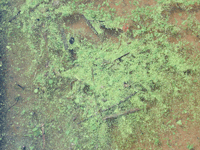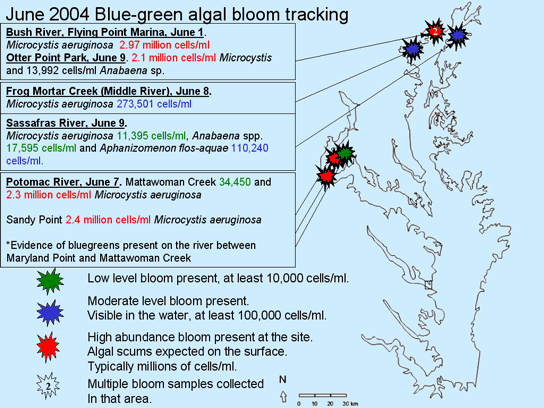Maryland Department
of Natural Resources (MD DNR), Department
of Health and Mental Hygiene (DHMH) and Department
of the Environment (MDE) are coordinating work to track blue-green
algal blooms in the Chesapeake Bay. Since June 1, blue-green algal blooms
dominated by the cyanobacteria Microcystis
aeruginosa, have been detected in the Bush River, Frog Mortar
Creek (Middle River) and the Potomac River (Mattawoman Creek and Sandy
Point north of Mallow Bay). A bloom identified in routine monitoring by
MD DNR on Wednesday, June 9, in the Sassafras River contains Microcystis
but is dominated by another blue-green algae, Aphanizomenon
flos-aquae (Figure 1).
 A
sample collected on June 1 at Flying Point Marina on the Bush River measured
2.97 million cells per milliliter. Samples collected on Monday, June 7
by the Academy of Natural Sciences Estuarine Research Center at Mattawoman
Creek and in the Potomac River 200 yards offshore of Sandy Point contained
2.3 million and 2.4 million cells per milliliter respectively. Microcystis
aeruginosa cell concentrations above 10,000 cells per milliliter
are known to negatively affect some aquatic life. Blue-green algal blooms
with at least 100,000 cells per milliliter may show an abundance of green
flecks in the water and swimming should be limited. When thick green algal
scums are forming cell concentrations are often in the millions of cells
per milliliter and pose the greatest concerns for health risks to pets,
livestock or human health if consumed and the algae contain the toxin
microcystin. Prolonged contact with the water may result in rashes or
other skin irritation. Swimming is not advised
in these situations. A
sample collected on June 1 at Flying Point Marina on the Bush River measured
2.97 million cells per milliliter. Samples collected on Monday, June 7
by the Academy of Natural Sciences Estuarine Research Center at Mattawoman
Creek and in the Potomac River 200 yards offshore of Sandy Point contained
2.3 million and 2.4 million cells per milliliter respectively. Microcystis
aeruginosa cell concentrations above 10,000 cells per milliliter
are known to negatively affect some aquatic life. Blue-green algal blooms
with at least 100,000 cells per milliliter may show an abundance of green
flecks in the water and swimming should be limited. When thick green algal
scums are forming cell concentrations are often in the millions of cells
per milliliter and pose the greatest concerns for health risks to pets,
livestock or human health if consumed and the algae contain the toxin
microcystin. Prolonged contact with the water may result in rashes or
other skin irritation. Swimming is not advised
in these situations.
 Maryland
DNR collected a sample on June 8 from Frog Mortar Creek (Middle River)
during routine maintenance of the continuous water quality monitoring
station that measured 273,501 cells per milliliter. This sample additionally
contained concentrations of other cyanophytes known as Anabaena
spp. at 13,992 cells/ml. Middle River has been experiencing a
persistent bloom of filamentous algae in most of its tributaries, however,
a survey of the area on June 10 found the blue-green algal bloom largely
concentrated in Frog Mortar Creek. Nearby Stansbury Creek and Dark Head
Creek appeared fouled by filamentous algae on and near the shores with
no signs of the blue-green algal bloom. The Chesapeake Bay at Miami Beach
Park between the mouth of Middle River and Seneca Creek looked clear and
showed no visible signs of either bloom. Maryland
DNR collected a sample on June 8 from Frog Mortar Creek (Middle River)
during routine maintenance of the continuous water quality monitoring
station that measured 273,501 cells per milliliter. This sample additionally
contained concentrations of other cyanophytes known as Anabaena
spp. at 13,992 cells/ml. Middle River has been experiencing a
persistent bloom of filamentous algae in most of its tributaries, however,
a survey of the area on June 10 found the blue-green algal bloom largely
concentrated in Frog Mortar Creek. Nearby Stansbury Creek and Dark Head
Creek appeared fouled by filamentous algae on and near the shores with
no signs of the blue-green algal bloom. The Chesapeake Bay at Miami Beach
Park between the mouth of Middle River and Seneca Creek looked clear and
showed no visible signs of either bloom.
On June 9, a diverse
cyanophyte community was identified with bloom waters on the Sassafras
River at Maryland's routine water quality monitoring station (ET3.1).
Microcystis, Anabaena planktonica and Aphanizomenon flos-aquae
were present. Anabaena density was 17,597 cells per milliliter,
Microcystis density was 11,395 cells per milliliter and Aphanizomenon
density dominated the sample with 110,240 cells per milliliter. This is
the first blue-green bloom sample for the Sassafras River in 2004.
The Bush, Potomac
and Sassafras Rivers were three of several river systems where widespread
blue-green algal blooms were found in 2003. Inadvertent swimmers reported
skin rashes, itching eyes, stomach aches and fever, and the hepatotoxin
(i.e., liver toxin) microcystin was detected in association with summer
cyanophyte (blue-green) blooms (see HAB News from October 30, 2003: "Microcystin
toxins found across Maryland's Chesapeake Bay in summer 2003.").
Not all blooms of blue-green algae produce toxins. Samples from the Bush
River, Potomac River and Frog Mortar Creek have been sent to Wright State
University to test for microcystin toxin content. Results are pending.

See Larger Version Of This Figure
Pockets of blue-green
algal blooms may be encountered during boating and other recreational
activities. People should take common precautions to reduce the risk of
illness or discomfort related to blue-green algal blooms:
- The
public should not swim in areas where a blue-green algae bloom is evident.
- Do not drink water from
any area with the appearance of a blue-green algae bloom.
- If contact is made with problem water,
simply wash off with fresh water.
In some cases, skin irritations may occur after prolonged contact. If
irritations persist, see a physician or local health care provider.
- Keep pets and livestock
away from bloom areas.
Blue-green algal blooms may contain toxins that could be harmful or
fatal to pets and livestock.
- Do
not eat viscera (internal organs) of fish caught in bluegreen bloom
waters.
Maryland
Department of Natural Resources is working in cooperation with Department
of the Environment, Department of Health and Mental Hygiene and Department
of Agriculture to continue monitoring the algal bloom conditions in the
Bay. For up to date information on all of Maryland's harmful algal blooms
and water quality, please visit Eyes on the Bay
|

 A
sample collected on June 1 at Flying Point Marina on the Bush River measured
2.97 million cells per milliliter. Samples collected on Monday, June 7
by the Academy of Natural Sciences Estuarine Research Center at Mattawoman
Creek and in the Potomac River 200 yards offshore of Sandy Point contained
2.3 million and 2.4 million cells per milliliter respectively. Microcystis
aeruginosa cell concentrations above 10,000 cells per milliliter
are known to negatively affect some aquatic life. Blue-green algal blooms
with at least 100,000 cells per milliliter may show an abundance of green
flecks in the water and swimming should be limited. When thick green algal
scums are forming cell concentrations are often in the millions of cells
per milliliter and pose the greatest concerns for health risks to pets,
livestock or human health if consumed and the algae contain the toxin
microcystin. Prolonged contact with the water may result in rashes or
other skin irritation. Swimming is not advised
in these situations.
A
sample collected on June 1 at Flying Point Marina on the Bush River measured
2.97 million cells per milliliter. Samples collected on Monday, June 7
by the Academy of Natural Sciences Estuarine Research Center at Mattawoman
Creek and in the Potomac River 200 yards offshore of Sandy Point contained
2.3 million and 2.4 million cells per milliliter respectively. Microcystis
aeruginosa cell concentrations above 10,000 cells per milliliter
are known to negatively affect some aquatic life. Blue-green algal blooms
with at least 100,000 cells per milliliter may show an abundance of green
flecks in the water and swimming should be limited. When thick green algal
scums are forming cell concentrations are often in the millions of cells
per milliliter and pose the greatest concerns for health risks to pets,
livestock or human health if consumed and the algae contain the toxin
microcystin. Prolonged contact with the water may result in rashes or
other skin irritation. Swimming is not advised
in these situations. Maryland
DNR collected a sample on June 8 from Frog Mortar Creek (Middle River)
during routine maintenance of the continuous water quality monitoring
station that measured 273,501 cells per milliliter. This sample additionally
contained concentrations of other cyanophytes known as
Maryland
DNR collected a sample on June 8 from Frog Mortar Creek (Middle River)
during routine maintenance of the continuous water quality monitoring
station that measured 273,501 cells per milliliter. This sample additionally
contained concentrations of other cyanophytes known as 